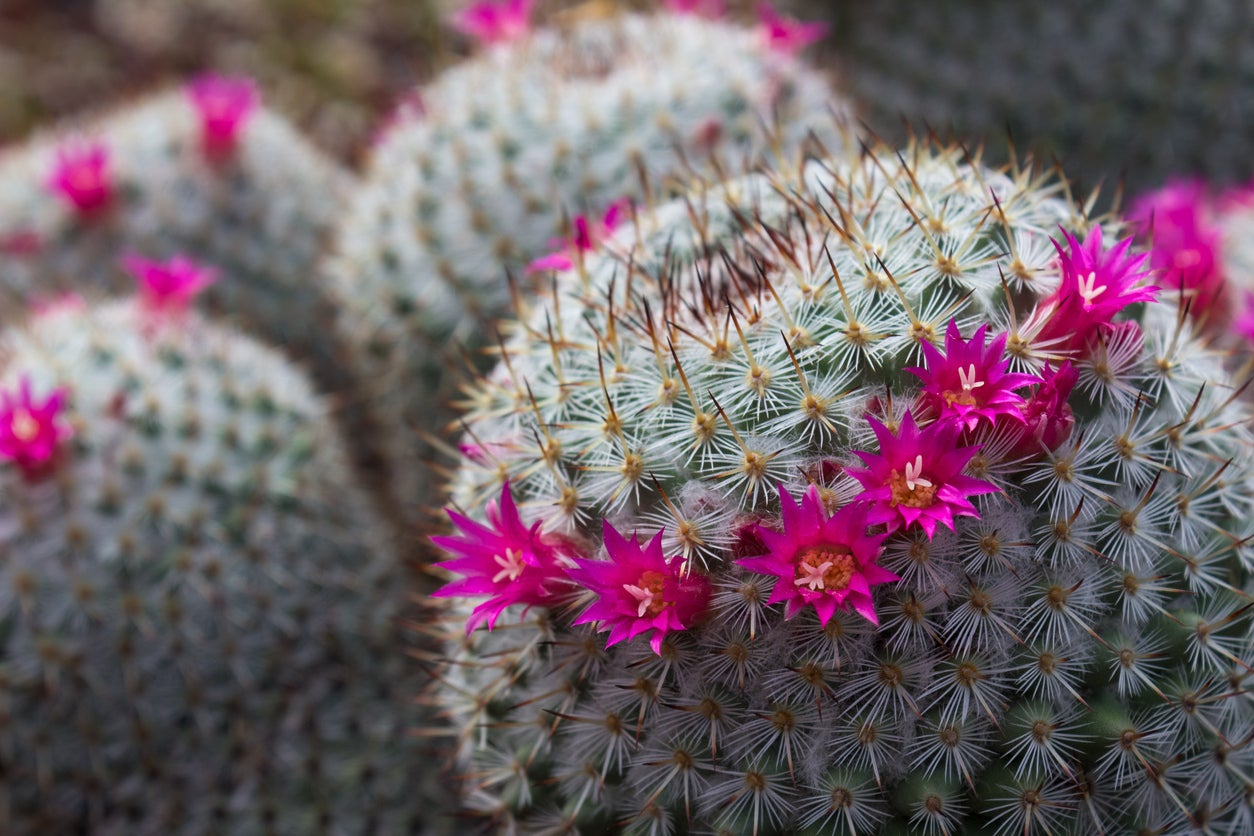Have you recently seen some strange things growing out of your succulent and are wondering, “What the heck is growing out of my succulent?!?” Succulents have some pretty strange habits, and the growths they make can be strange and hard to understand. No need to panic though, in most cases these anomalous growths are harmless. Let’s see if we can identify what’s growing out of your succulent with the pictures below.
Many succulents bloom with tall, spiny or strangely colored flower stalks. Some don’t even produce leaves on the stalks. Flower stalks give succulents a chance to reproduce sexually through pollen and seeds.
If you see a fluffy black growth on one of your cacti, it’s about to flower!
The cactus below is about to flower and is also for sale on Etsy! Shop small!
You might also like: The Resilient and Beautiful Aloe Brevifolia: A Low-Maintenance Succulent for Your Home
You might also like: Monocarpic Succulent Death Bloom: The Complete Guide to Growing and Caring for These One-of-a-Kind Plants and 4 Possible Ways to Save Yours
Seeing a beautiful flower emerge from your prized cactus can be a surprising and exciting event But is this floral show a sign of good health or cause for concern? Let’s explore what it means when a flower grows out of a cactus,
Why Do Cacti Produce Flowers?
Flowering is a natural part of the life cycle for most cacti species, Here are some key reasons they bloom
-
Reproduction – Flowers play a critical role in reproduction by attracting pollinators. This allows the plant to produce seeds and propagate.
-
Seasonal cues – Many cacti initiate flowering based on seasonal cues like temperature light levels and rainfall. Flowering typically occurs during spring and summer.
-
Maturity – Mature, established cacti are more likely to bloom than younger specimens. Flowering indicates the plant is no longer focusing energy on growth.
-
Health – Robust, healthy cacti often produce the most spectacular floral displays. Vigor and appropriate care promotes flowering.
So in most cases, flowers signal the cactus is thriving and has reached a stage where it is ready to reproduce. But there are exceptions…
When Flowers Indicate Problems
While flowering is normal, in some cases it can suggest issues with the cactus:
-
Stress bloom – Some cacti will bloom when stressed by drought, damage, or poor growing conditions. This stress response is the plant’s effort to save its genes.
-
Lack of light – Insufficient light can trigger some cacti to flower in a last ditch attempt to pass on genes before dying.
-
Root restriction – A plant that has outgrown its pot may bloom prematurely due to cramped roots. Time to repot!
-
Poor nutrition – Inadequate fertilization or depleted soil can cause desperate blooming.
-
Pest attacks – Pests like mealybugs, mites, and thrips can stimulate flowering. Treat any infestations!
-
Diseases – Certain bacterial and fungal diseases are linked with cacti blooms, especially if blooms are small or abnormal.
So take note of any cultural issues or signs of illness if your cactus seems to be blooming excessively or at odd times. Addressing problems can lead to healthier growth.
Tips for Promoting Flowering in Cacti
If your cactus refuses to bloom, have patience! Here are some tips to coax those flowers out:
-
Ensure the plant gets bright but indirect light. A sunny south or west window is ideal.
-
Use a fast-draining cactus/succulent soil and avoid overwatering. Too much moisture inhibits blooms.
-
Repot into a slightly larger container if roots are crowded. This encourages flowers.
-
Feed monthly in spring and summer with a balanced fertilizer to fuel growth and buds.
-
Give the plant a cool rest period in fall/winter with reduced watering to stimulate blooming.
-
Allow the soil to dry out between thorough waterings to mimic desert conditions.
-
Plant in a group with other cacti for better pollination. Or use a small brush to manually pollinate.
-
Avoid repotting or drastic pruning right before flowering periods.
With the right care simulating its native habitat, most cacti will produce stunning blooms in time!
What to Do After a Cactus Flowers
When those long awaited blooms finally appear, then what? Follow these tips for post-flowering care:
-
Admire the flowers! Take photos and share with other cactus lovers.
-
Pollinate the flowers using a small brush or cotton swab if desired. This results in seed pods.
-
Expect flowers to last 1-2 weeks, sometimes longer.
-
Remove spent flowers by twisting or snipping off at the base. Don’t yank.
-
Resume normal fertilizing practices after flowering concludes.
-
Watch for seed pods to develop if pollination occurred. Leave the pods be.
-
Give the plant a bit more water, light, and nutrition to recover from blooming.
-
Expect reduced growth or slower flowering the following year after a heavy bloom period.
With the proper care after flowering, your cactus will return to normal growth and likely bloom again when conditions are right!
Causes of Weird Growths on Cacti
Sometimes cacti produce odd growths other than flowers, which can be concerning. What causes strange structures like:
-
Bulbous or mushroom-like blobs
-
Hair-like spikes
-
Root-like elongated growths
-
Blisters, knots, or bumps
-
Abnormal branching patterns
While alarming, these weird cactus growths are often completely normal and nothing to worry about. Here are some common reasons they occur:
-
Natural structures – Many cacti just grow that way, especially species like the Medusa head or Eve’s pin. Their funky forms are part of their natural look.
-
Aerial roots – Elongated root-like growths help absorb moisture and nutrients. Common on epiphytic cacti.
-
Pups – Clusters of bulbous offsets form as the main plant reproduces vegetatively.
-
Galls – Bulbous or tumor-like growths caused by various pests, fungi, bacteria, or mites. Harmless but unsightly.
-
Scars – Old injury sites, common on columnar cacti. The structures are often more prominent as the plant grows.
-
Crests/fasciations – Flattened, fan-like, or bizarrely shaped growth from abnormal stem tissue. Harmless mutation.
So before taking action on odd growths, do some research to see if it is simply the normal form of your particular cactus species. Unusual structures are not necessarily dangerous or detrimental!
When to Worry About Growths on Cacti
However, not all strange cactus growths are benign. Watch for these signs of problems:
-
Soft, mushy areas that spread – Potential fungal or bacterial rot.
-
White cottony tufts – Mealybug infestation.
-
Tiny insects swarming – Possible thrips, mites, or other pests.
-
Discolored or corroded spots – May indicate a disease like cactus rust.
-
Distorted, asymmetrical growth – Could be mutation from a virus.
-
Bulges oozing liquid – Bacterial infection.
Any growth that seems to be spreading, worsening, or compromising the integrity of the cactus warrants immediate investigation and treatment. Catch issues early before they threaten the health of the plant.
When in doubt about weird growths, ask an expert! Most are harmless but it pays to identify them. Your oddly shaped cactus may just be perfect in its own special way.
Final Thoughts on Cactus Flowers and Growths
Seeing new structures arise on your cherished cacti can be exciting, alarming, or confusing! Learn to recognize what is part of the plant’s natural development and when intervention is called for. With attentive care, most cacti will thrive and their unique features can be appreciated. So sit back and enjoy the show as your plant matures – flowers and all!
Why is my succulent growing a stalk?
There are a few reasons why a succulent may start to grow a tall stalk or stem:
- Flowering: As part of their natural process of flowering and reproducing, many succulents grow tall flower stalks. This makes the flowers and seeds easier for pollinators to see and get to.
- Origin: If a succulent doesn’t get enough sunlight, it may start to grow longer and stretch toward the light. This etiolation causes long, weak growth.
- Top heaviness: If the top of some succulents grows faster than the roots can support, the plant can become top heavy. The plant then sends up a stalk to make the top higher.
- Through hybridization, some hybrid succulents are more likely to grow long stalks because of their genes.
- Different kinds of succulents—Some, like Echeveria, grow rosettes on top of long stems on their own as they get older.
- When it gets cooler, some succulents start to stretch and lean toward heat sources like grow lights or sunlight.
Pups are miniature clones of the parent succulent that bud off at the base. You’ll see this a lot in Echeveria and Echeveria hybrids. Pups are kind of like babies for succulents and allow them to propagate naturally. If you see little succulent rosettes sprouting from the main plant, those are probably pups.
You might also like: Propagating Succulents 4 Ways: The Best Guide Ever
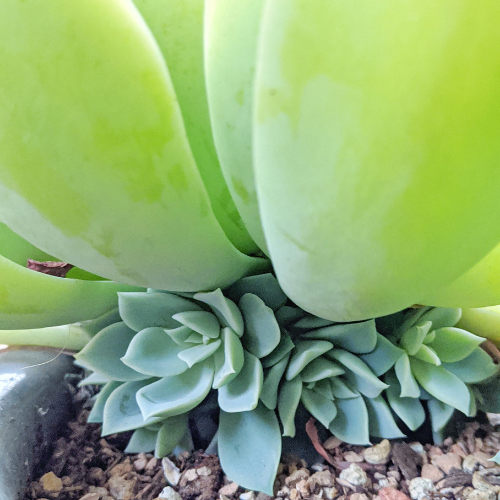
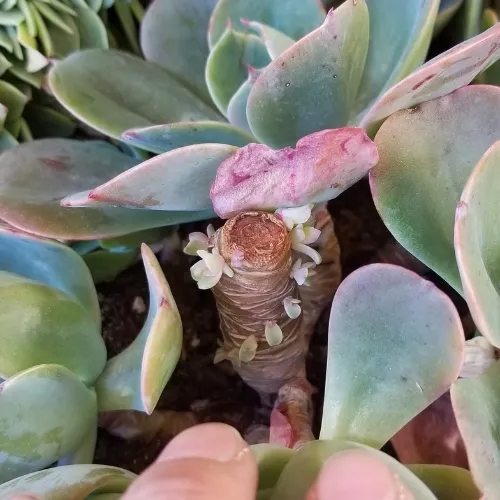
Long stems with roots that spread out along the soil’s surface are made by some succulents, like Echeveria prolifica. At the end of these stems, little plants grow. These are known as runners and allow the succulent to propagate itself through vegetative growth. Runners can take root anywhere along their length.
Click on the below to support a small business and add Echeveria prolifica to your succulent collection!
You might also like: Echeveria prolifica
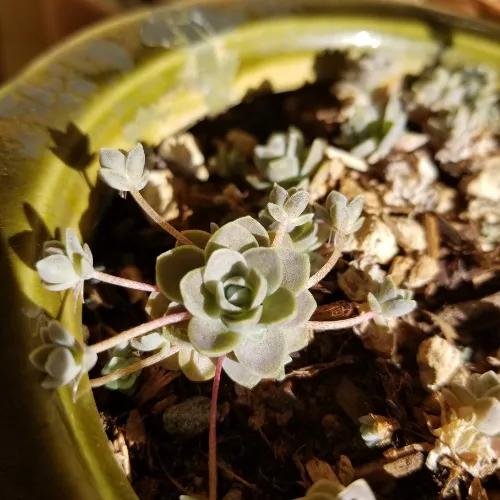
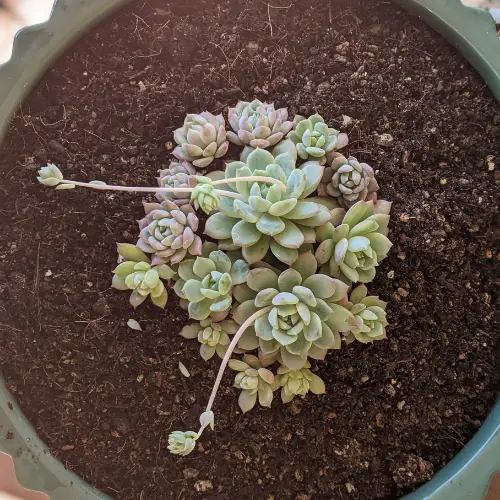
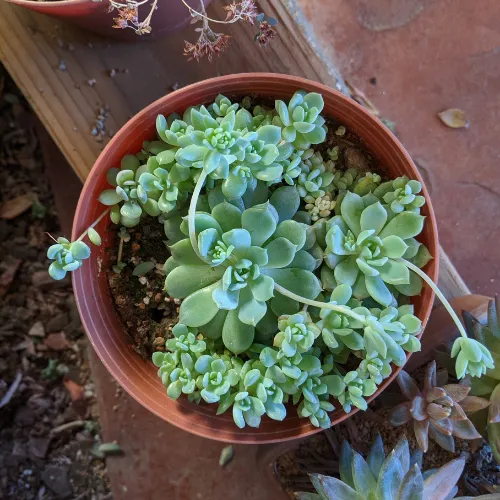
As a response to low humidity or root rot under the soil
Occasionally succulents develop roots that extend out into the air, rather than anchoring in soil. These aerial roots are intriguing but mainly provide no benefit. The theory is that they’re trying to extract moisture from the air. They can often be removed without causing any harm. Also, check the roots under the soil to make sure they’re healthy.
Some succulents, like Kalanchoe marnieriana, have aerial roots that do go into the ground and give the plant more support. More on aerial roots here: What are aerial roots? A guide to this interesting adaptation.
You might also like: Graptoveria ‘Fred Ives’ Complete Guide to Its Care
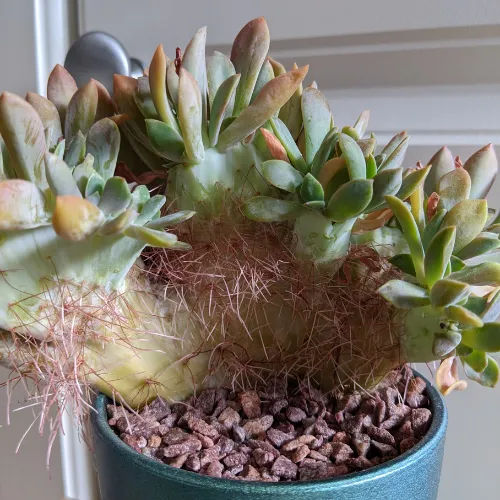
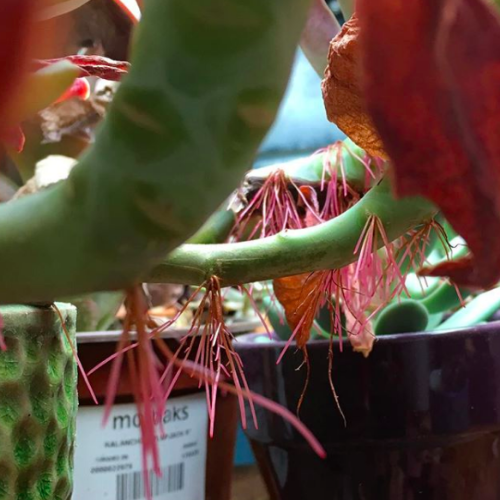
Root nodes grow out of the stem of trailing succulents like “String of Bananas” and other types of succulents that touch the ground. They look like little bumps at first. They help anchor the succulent in the soil and create a more robust root system.
‘String of Watermelons’ (Senecio herreianus) tends to grow a lot of root nodes. Click on the below to support a small business and purchase one from their Etsy shop!.
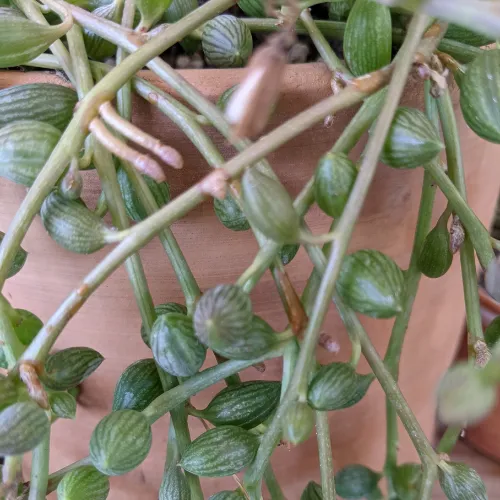
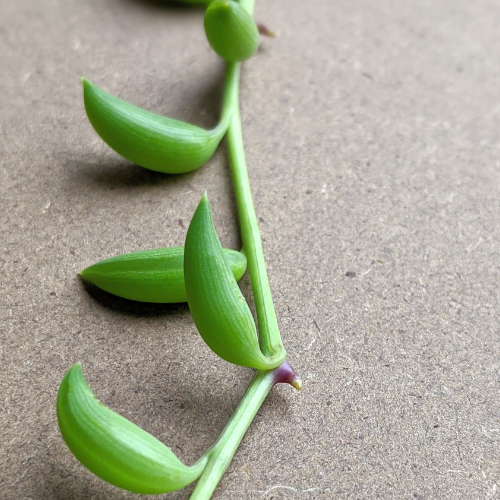
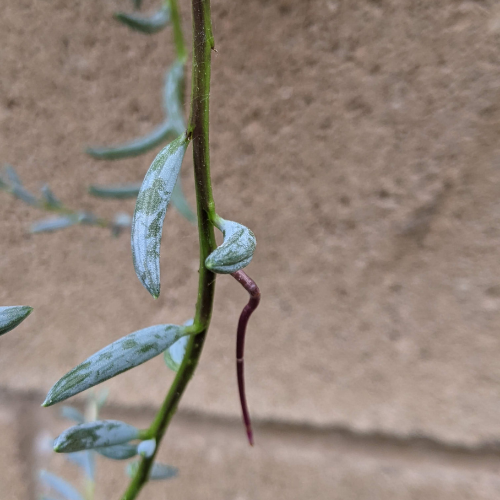
Some succulents like Aloe and Agave produce offsets which are clones that form from the roots underground. They have their own root system though so they can eventually become independent plants. Offsets are a way for succulents to spread out and colonize new areas. The offsets will often pop up yards away if grown in the ground. (Pictures to come).
You might also like: Agave Parryi: A Comprehensive Guide to This Hardy Landscape Succulent
How To Get Your Cactus To Flower
When does a Cactus Flower?
Flowering Time: Summer and Fall Native to Mexico, it forms a globe-shaped structure and has bright green stems with spiked ribs. The contrasting yellow-colored areoles pair well with bright yellow blooms. 19. Old Lady Cactus Botanical Name: Mammillaria hahniana Flowering Time: Spring and Summer
What cactus grows in Mexico?
Mammillaria genus is native to the desert areas of Mexico. It forms a cluster of columnar or spherical stems and carries beautiful funnel-shaped pink flowers. 20. Chin Cactus Botanical Name: Gymnocalycium neuhuberi Flowering Time: Spring and Summer
Can you grow a cactus with flowers?
A cactus with flowers is a lovely sight. Here’s how to cultivate your own! Cacti are popular plants that are grown by gardeners and collectors all over the world. These hardy plants can be grown indoors, outdoors, in greenhouses, and under glass. They are relatively easy to grow when conditions are right.
Do cactus flowers have spines?
The cactus stems are arranged in a flat rosette and have no spines. This is a delightful little blooming cactus plant that has the most spectacular glossy yellow flowers. These grow from the crown and can reach a length of 3 inches (7.5 cm). To add to their beauty, these flowers are also sweetly-scented.
- The Ultimate Guide to Growing Strawberries in Raised Beds - August 8, 2025
- No-Dig Garden Beds: The Easiest Way to Grow a Beautiful Garden - August 6, 2025
- How to Protect and Preserve Wood for Raised Garden Beds - August 6, 2025

